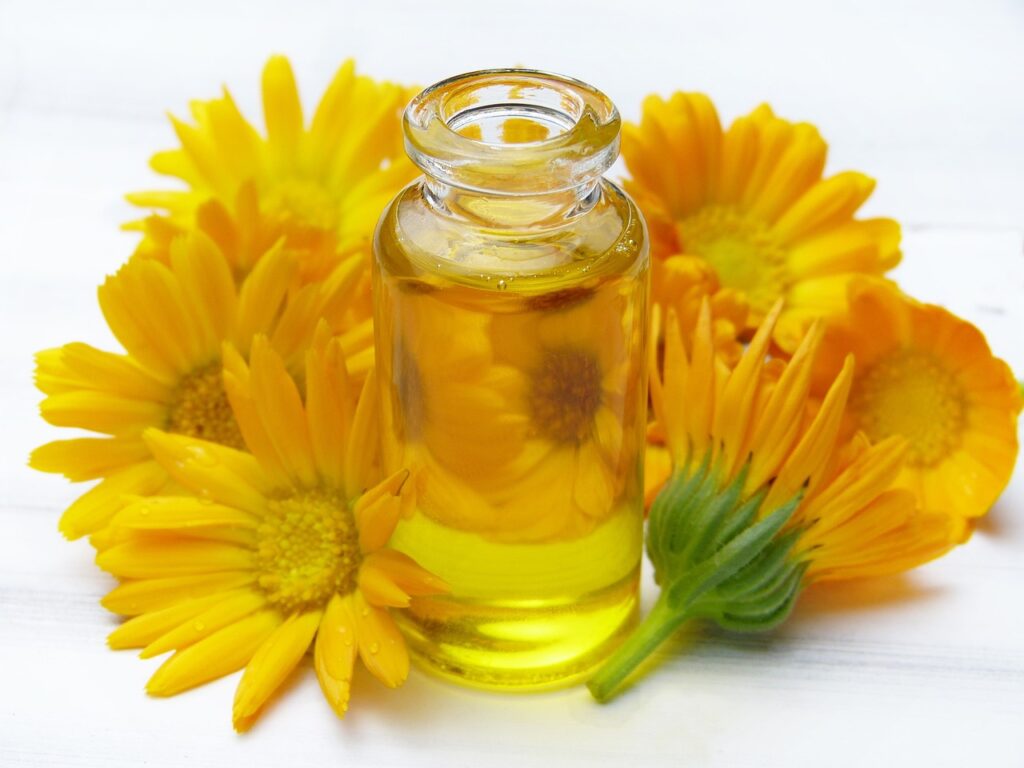For thousands of years, Calendula, known as pot marigold, has been used for its culinary and medicinal uses due to its anti-inflammatory and healing properties. From brewed teas and tinctures to skin care, Calendula is a powerhouse when it comes to Mother Nature’s healing power.
What is Calendula Oil?
Calendula oil, which is oil extracted from flowers from the Calendula officinalis plant, is a popular ingredient in ointments, creams, and salves for its soothing properties. The flower contains flavonoids and triterpenoids that provide strong anti-inflammatory effects.
Calendula is rich in antioxidants like carotenoids and flavonoids, which protect the skin and body from oxidative stress. That makes it the perfect plant ally for epidermal ailments such as wound healing or minor skin issues, such as psoriasis and eczema.
How to Make Your Own Calendula Oil
- Ingredients:
- Fresh or dried calendula petals
- Carrier oil (olive, sweet almond, jojoba, or sunflower oil)
- Glass jar
- Cheesecloth or strainer
- Step-by-Step Process:
- Harvest or purchase fresh or dried calendula petals. (Dried herbs are preferred for preventing mold contamination due to excesses water from the fresh leaves.)
- Fill a glass jar with petals and cover them completely with your carrier oil of choice.
- Seal the jar and let it sit in a warm, sunny spot for 4–6 weeks, shaking the jar occasionally.
- Strain the oil through cheesecloth or a fine strainer into a clean jar.
- Store the oil in a cool, dark place for up to a year.
7 Healing Ways to Use Calendula Oil
1. As a Soothing Skin Balm – Apply directly to dry or irritated skin, especially for eczema or psoriasis.
2. For Healing Minor Cuts and Scrapes – Use as a natural first-aid remedy to speed up healing and prevent infection.
3. To Soothe Sunburn or Minor Burns – Apply to burned skin for its anti-inflammatory and cooling effects.
4. In a Relaxing Massage Oil – Mix with essential oils like lavender or chamomile for a calming massage experience.
5. As a Baby-Safe Diaper Rash Treatment – Gentle enough for babies, calendula oil can help heal diaper rash naturally.
6. In a Hydrating Face Serum – Add a few drops to your daily skincare routine for extra moisture and protection against acne.
7. For Scalp Health and Hair Care – Massage into the scalp to reduce dandruff or add shine to dry, brittle hair.
Tips for Storing and Preserving Calendula Oil
Storing Calendula oil properly helps preserve its quality, potency, and shelf life. Here are some tips:
Use a Dark Glass Bottle: Store the calendula oil in a dark amber or cobalt blue glass bottle to protect it from sunlight, which can degrade its therapeutic properties.
Keep Away from Heat: Store the oil in a cool, dry place, away from direct heat sources like radiators, ovens, or hot windowsills. Excessive heat can cause the oil to go rancid faster.
Avoid Exposure to Air: Make sure the bottle is tightly sealed to prevent exposure to air, which can lead to oxidation and spoilage.
Label the Bottle: Mark the bottle with the date it was made or purchased, and include the expiration date (usually about 1 year from the time it’s made).
Refrigeration: If possible, store the oil in the refrigerator. The cool temperature helps extend its shelf life and keeps it fresh longer. Be aware that the oil may thicken in colder temperatures but will return to liquid form at room temperature.
Add a Natural Preservative: Adding a few drops of vitamin E oil can help extend the shelf life of calendula oil, as vitamin E acts as a natural preservative and antioxidant.
Check for Spoilage: Over time, oils can develop a rancid smell or change in texture. If you notice any off odors, cloudiness, or separation, it’s best to discard the oil.
Small Batches: If making your own calendula oil, create smaller batches to ensure you use it while it’s fresh.
I hope you have learned a few ways to start incorporating the powerful and versatile uses of Calendula oil into your everyday health routines. From its remarkable ability to heal and soothe skin irritations, wounds, and burns to its anti-inflammatory and antimicrobial properties, this golden-hued oil is a must-have in any holistic health toolkit.
I’d love to hear your favorite way to use Calendula oil down below.
Happy growing, my friends!

